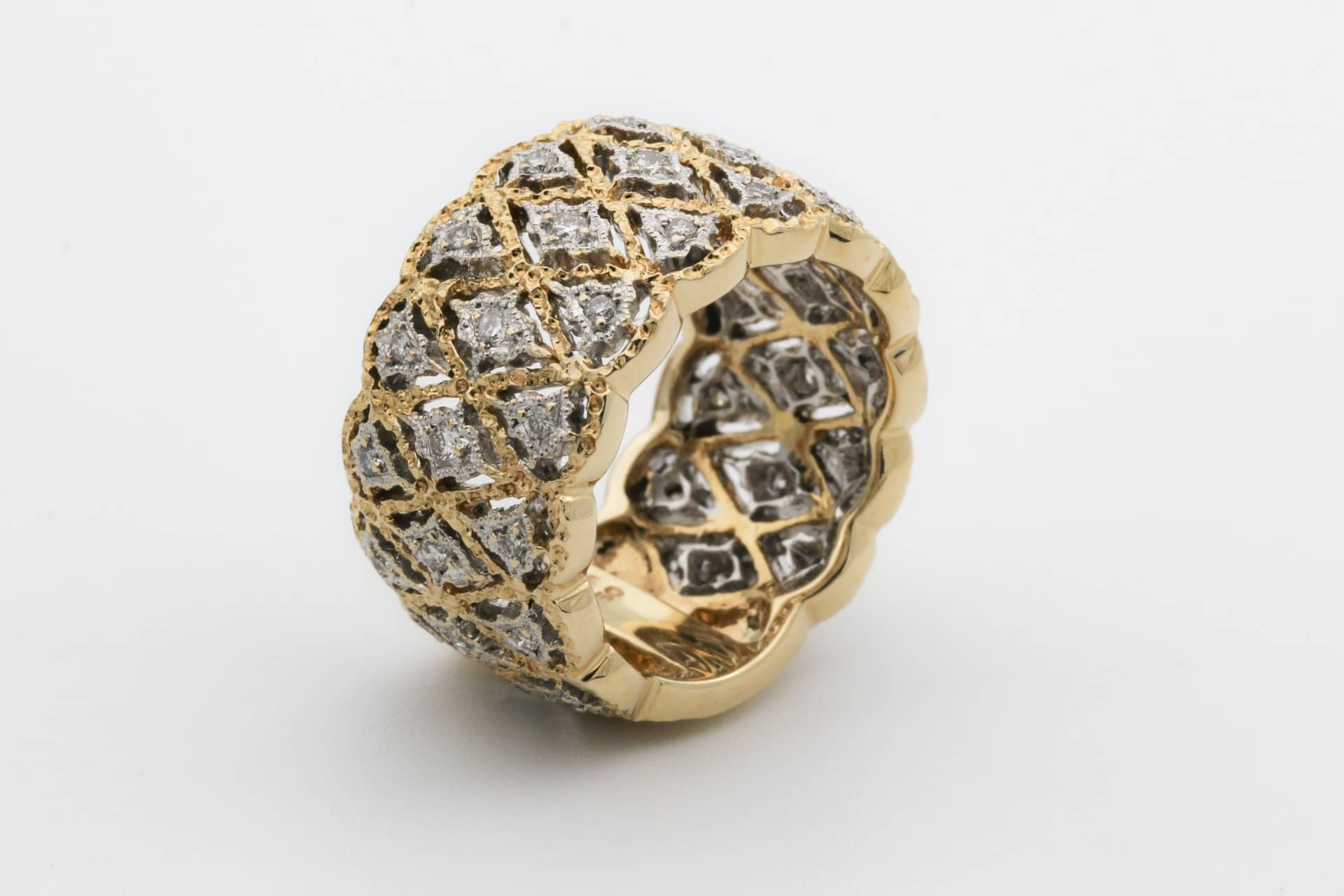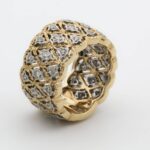How To Identify Fake Iced Out Jewellery

How To Spot Fake Iced Out Jewellery
Iced out jewellery is a style of jewellery that is covered in diamonds, which gives chains, pendants, rings and more an unmistakable sparkle. But how can you spot if your iced out jewellery has been crafted from genuine gold and diamonds? In this blog, the experts at Hatton Jewellers share how you can tell the fakes from the real thing - and what difference it really makes.
What Is Fake Iced Out Jewellery?
Fake iced out jewellery is just like any other type of fake jewellery - it’s made from less precious metals and gemstones.
Iced out jewellery can be adorned with either diamonds or another sparkling gemstone - usually cubic zirconia (CZ). However, to be truly considered real iced out jewellery the piece should be made from solid gold and studded with diamonds.
It’s not uncommon to see gold-plated iced out jewellery either. On the face of it, gold-plated jewellery looks almost identical to real gold. However, there are many subtle differences between gold-plated and solid gold jewellery. Gold-plated pieces are typically made from a cheaper material such as brass, and then coated with a thin layer of gold. This makes gold-plated jewellery much less durable. Prone to scratches, likely to tarnish and with the potential to stain your skin, gold-plated jewellery might only last a few years before it looks visibly worn. It’s advisable to choose solid gold iced out jewellery to ensure the piece looks stunning for many years to come.
Top 5 Ways To Identify Fake Iced Out Jewellery
Here are some of the best ways to tell if your shiny gold chain is the real deal:
- Check your certificate of authenticity
- Look out for the hallmark
- Check its weight
- Ask about the price
- Hold a magnet to your jewellery
A reputable jeweller will provide you with a certificate of authenticity or an insurance valuation. This document states exactly what your jewellery is made of, from the metal purity through to whether your piece contains diamonds or cubic zirconia, giving you complete peace of mind in your purchase.
Gold, silver, platinum or palladium - above a certain weight threshold - must be hallmarked. This is a legal requirement under the UK Hallmarking Act of 1973. A hallmark will tell you what metal (and metal purity) your jewellery is made from. Take a look at our hallmark chart to help you check if your jewellery has the right stamp. If your iced out jewellery doesn’t have a clear hallmark, it’s almost definitely not made from solid gold, silver, platinum or palladium.
You can also usually spot a fake gold chain just by its weight. Solid gold jewellery is likely to be much heavier than other metals such as nickel. If your gold chain feels light to hold, it could be a gold-plated option.
If you’re considering buying a piece of iced out jewellery, do some market research to find out what the average price of the piece should be. If a 9ct ring with around 0.5ct of real diamonds costs between £1,500 - £2,000 from a range of reputable jewellers, yet you’ve discovered a ring that purports to be the same spec for £500, it’s likely you haven’t found a bargain - you’ve found a fake.
Gold and silver are not magnetic. If you place a magnet onto the metal of your iced out jewellery, and it sticks, then you have likely bought a counterfeit piece.
If you’re trying to spot fake iced out stones, then use our methods below to check out if your chain’s gemstones contain real diamonds or not.
Checking Your Iced Out Jewellery’s Diamonds For Authenticity
Diamonds are a precious stone but, unfortunately, there are plenty of look-alikes out there that could trick you at first glance. From colourless sapphire and moissanite to crystals made in labs such as gadolinium gallium garnet, it can be hard to tell whether your sparkling gem really is a diamond.
- Get to know your 4Cs
- Try the fog test
- Look out for scratches
- Speak to a reputable jeweller
Diamonds that are purchased from a reputable jeweller should come with a certificate of authenticity and/or a gemological report. This should detail what carat, colour, clarity and cut your diamond is. If you’re not sure what the 4Cs mean or their importance, take a look at our diamond guide.
Breathe on your diamond, and watch what happens when the fog disappears. Diamonds disperse heat quickly so, If the fog clears rapidly, then it’s likely your iced out jewellery contains real diamonds.
Most people will know that diamonds only scratch diamonds. That’s because diamonds come top of the Mohs scale of mineral hardness, so they’re very hard to damage. If you notice your iced out jewels become scratched or damaged, then it’s likely they’re made of a different gemstone altogether.
A jeweller will be able to advise whether your iced out jewellery is likely to contain real diamonds. Jewellers have access to a professional 10x magnifying glass (called a loupe) that will help to identify any inclusions, colour and the sharpness of your stone’s facets - all indicators of whether your diamond is real or not.
Why Should I Buy Real Iced Out Jewellery?
Iced out jewellery typically signifies wealth and status. Gold chains that are dripping with diamonds have been loved by rappers and hip-hop artists since the 70s - and the trend shows no sign of slowing down.
Though fake iced out jewellery does display much of the same extravagance, those truly looking to showcase some serious bling should only ever buy solid gold encrusted with natural, certificated diamonds.
You might not be able to identify the difference immediately, but those with a keen eye for the real deal will be able to spot the sparkle of an authentic diamond. Plus, real iced out jewellery is crafted to last you a lifetime. If you’re looking to treat yourself or a loved one to a stand-out piece for their jewellery collection, you should always select solid gold that is durable, harder wearing and ready to be treasured for years to come.
Check out our iced out jewellery guide for all you need to know about this statement style.
Should I Wear Fake Jewellery?
‘Fake’ jewellery doesn’t always translate to low-quality jewellery - though it’s important which elements of your jewellery you choose to upgrade or not. A gold-plated ring with cubic zirconia is no comparison for a high quality 18ct solid gold ring studded with diamonds. That said, there are a few hints and tips to help you add to your iced out jewellery collection without breaking the bank.
If you’re looking for an affordable jewellery option, swapping diamonds for cubic zirconia could be a cost-effective yet stylish choice. The main advantage of cubic zirconia jewellery is that they are a cheaper alternative to diamonds. In some cases, diamonds can be up to four times more expensive - particularly if they’re natural diamonds.
Cubic zirconia, though a man-made crystal, can also be made to an extremely high standard, to the point where it’s almost impossible for the human eye to tell the difference between CZ and diamond.
It’s also a good idea to choose solid gold instead of gold-plated jewellery where at all possible. Cheaper alternatives such as 9ct gold will make a difference to your price point whilst also offering the quality and durability of higher carat gold jewellery.
Where Can I Buy Iced Out Jewellery?
Here at Hatton Jewellers, we sell a range of iced out jewellery to suit all budgets. From solid gold chains adorned with real diamonds to affordable cubic zirconia pendants, we make sure our high-quality pieces are made to last.
You should only ever buy iced out jewellery from reputable jewellers, to ensure you’re getting the right quality of jewellery made from the precious metals you were promised. Here are our top tips for choosing a reputable iced out jeweller:
- Make sure the jeweller offers hallmarked jewellery and, preferably, an insurance valuation. This gives you full peace of mind you’re walking away with exactly what you paid for.
- Look into the product details. You should know exactly what carat and diamond grade you’re buying. If a jeweller simply lists ‘costume’ jewellery, it’s likely to be gold plated.
- Read the reviews on a trusted review site such as Trustpilot. Find out what previous customers have to say - this will give you an idea of whether the jeweller is reputable or not.
- Ask questions. If you’re eyeing up a piece of jewellery but you’re not sure of the diamond carat, colour or clarity, a reputable jeweller should always be more than happy to help.
If you’re browsing online to select your iced out pieces, take a look at our specific advice on buying jewellery online.
For all the latest advice on iced out jewellery trends, check out our Hatton Jewellers blog or show off your bling on Instagram or Facebook.


